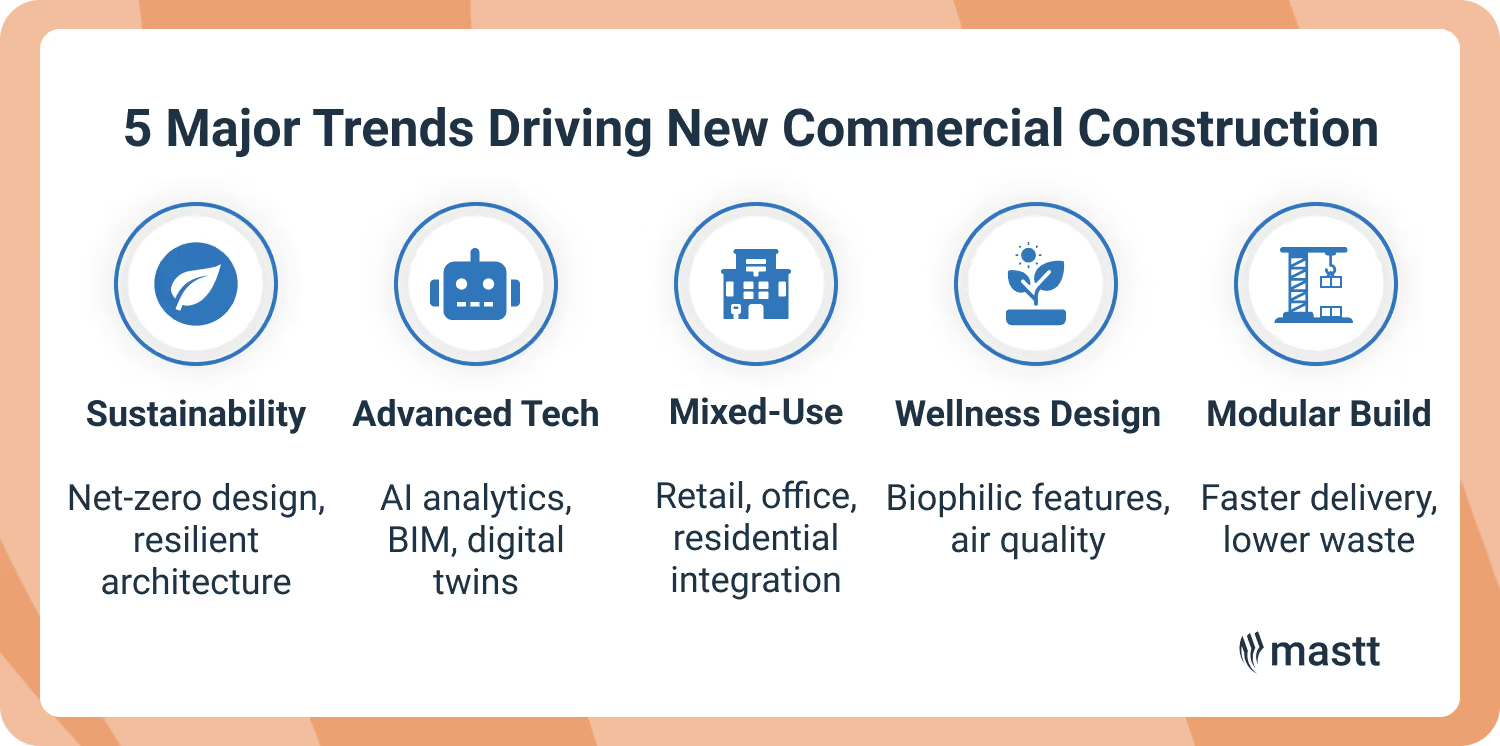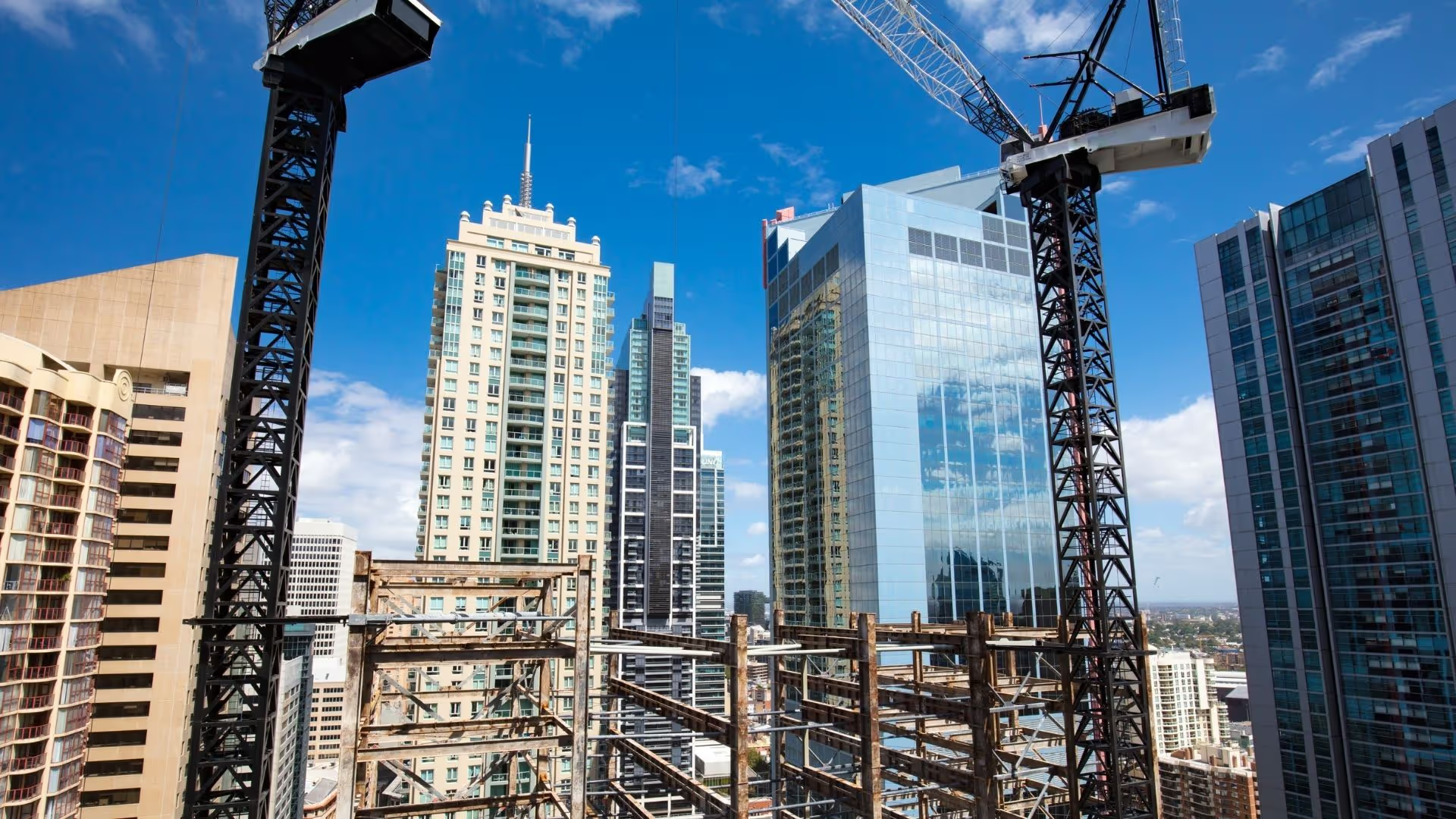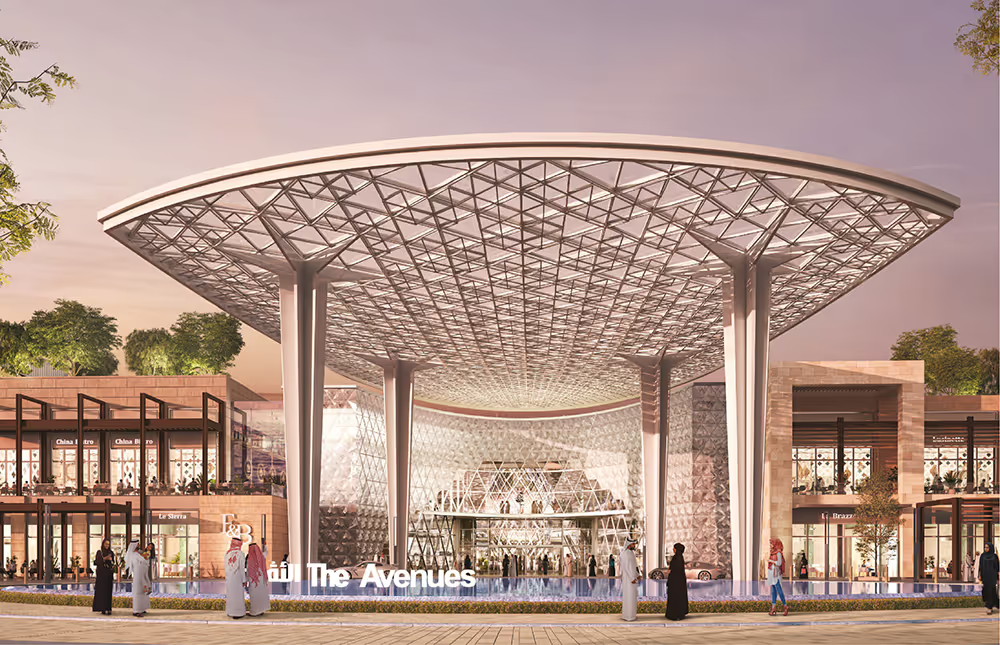New commercial construction involves creating entirely new commercial spaces built from the ground up. Unlike renovations, they allow full design freedom to add modern technologies, sustainable systems, and layouts that drive growth and redefine city spaces.
This article talks about new commercial construction, highlighting key trends, common challenges, and strategic planning methods to deliver efficient, future-ready developments.
5 Major Trends Driving New Commercial Construction in 2025
Sustainability mandates, advanced technology, and design innovation are driving new commercial construction this year. Developers and investors who act on these trends now can capture higher returns and reduce risk.
Here are new commercial construction trends driving demand, shaping investments, and creating market advantages:
1. Sustainability and Green Building Practices
Sustainability and green building meet regulations, attract Environmental, Social, and Governance (ESG) investors, and boost long-term property value. They also reduce operational risks and position projects for stronger performance in competitive markets.
Key drivers of sustainability and green building in new commercial construction include:
- Net-zero design: Cuts a building’s carbon emissions through energy efficiency and renewable power.
- Resilient architecture: Shields properties from climate risks and operational disruptions.
- ESG-driven planning: Aligns projects with environmental, social, and governance standards that secure funding.
Sustainable properties lease faster to premium tenants and deliver long-term profitability. Selecting the right commercial general contractor ensures that certifications are met, schedules are adhered to, and asset value is maintained or grows.
2. Advanced Construction Technology
Advanced construction technology revolutionizes new commercial construction by leveraging data-driven tools that enhance efficiency, reduce costs, and increase long-term value. These tools provide developers with greater control over budgets, schedules, and building performance, from planning to post-completion.
Core influences of technology adoption in new commercial construction include:
- AI-powered analytics: Flags cost overruns early, resolves scheduling conflicts, and supports faster, data-driven decisions.
- Building Information Modeling (BIM): Coordinates designs across trades to cut rework and reduce material waste.
- Digital twins: Tracks real-time building performance for predictive maintenance and higher tenant satisfaction.
AI analytics flag budget risks before procurement, while BIM eliminates rework by aligning architectural and engineering plans. Digital twins track post-occupancy performance, enabling targeted upgrades that maintain tenant satisfaction and preserve asset value.
3. Mixed-Use and Adaptive Reuse Projects
Mixed-use and adaptive reuse projects combine property types or repurpose existing buildings to maximize a site’s income potential. Developers are converting vacant structures into profitable assets or creating multi-use spaces that meet shifting market demand.
Key drivers of mixed-use and adaptive reuse in new commercial construction include:
- Integrated income streams: Combine retail, office, and residential space to keep revenue consistent.
- Incentive programs: Leverage tax credits and grants for adaptive reuse or historic renovation projects.
- Lower build costs: Reuse existing structures to reduce demolition expenses and material waste.
Well-executed projects in this category can serve as a cornerstone for neighborhood revitalization and attract long-term investment. Misjudging market needs or overlooking structural limits, however, can erode returns before lease-up.
4. Wellness-Centric Design
New commercial buildings are increasingly designed to boost health, comfort, and productivity for the people who use them. Flexible layouts, biophilic elements, and better air quality are now key to attracting premium occupants.
Core features driving wellness adoption include:
- Flexible layouts: Adaptable spaces support changing tenant needs and multiple uses.
- Biophilic features: Natural light, greenery, and materials enhance comfort and productivity.
- Improved air quality: Advanced filtration reduces health risks and boosts occupant satisfaction.
Flexible layouts increase lease renewals by adapting to shifting tenant demands, while biophilic features shorten vacancy periods in competitive markets. Advanced air systems maintain indoor quality ratings that support premium rents and long-term tenant retention.
5. Modular Construction Advancements
Modular construction is gaining adoption due to its ability to speed up delivery, reduce waste, and improve build quality through off-site manufacturing. Developers are utilizing this method to enhance efficiency, minimize site disruptions, and manage project costs.
Catalysts of modular construction adoption in new commercial construction include:
- Faster delivery: Shortens build schedules by manufacturing modules while site work is underway.
- Consistent quality: Uses controlled environments to maintain precise standards and reduce defects.
- Lower waste: Minimizes material use and supports sustainability goals.
Projects built using modular methods can reduce financing costs, improve predictability, and create assets that generate returns more quickly. The global modular construction market worth $104B in 2024 market will hit $140.8B by 2029, creating stronger opportunities for developers.

Key Challenges in New Commercial Construction and How to Manage Them
New commercial construction projects face market, operational, and environmental pressures that can reduce profitability if not addressed early. Developers and investors need targeted strategies to keep builds on track and maintain asset value.
Key challenges in new commercial construction demand careful planning and proactive risk and opportunity management to prevent costly delays.
1. Economic Volatility: Shifting interest rates and market demand can alter financing models for new commercial construction projects.
✅ Solution: Secure diverse funding, track market indicators, and use public-private partnerships to project project capital flow.
2. Supply Chain Disruptions: Material shortages and cost spikes can delay schedules and impact quality in new commercial construction builds.
✅ Solution: Diversify suppliers, source locally where possible, and apply predictive analytics to avoid costly material delays.
3. Labor Shortages: Limited skilled labor increases build times and can compromise standards in large-scale commercial projects.
✅ Solution: Expand training programs, improve jobsite conditions, and deploy automation to maintain productivity and quality.
5. Regulatory Complexities: Changing building codes and slow permitting can disrupt timelines for commercial construction developments.
✅ Solution: Engage authorities early, complete due diligence before permits, and retain consultants for specialized compliance guidance.
6. Climate Change Impacts: Extreme weather events can damage worksites and threaten the long-term performance of commercial buildings.
✅ Solution: Integrate resilient design, plan deep-energy retrofits, and prepare for extreme weather to protect asset performance and ensure optimal performance.
In new commercial construction, proactive challenge management safeguards project timelines, controls costs, and protects long-term ROI. With the right project manager, developments can outperform peers and capture premium market demand.
Material, labor, and financing pressures are putting more strain on projects. Knowing the latest construction cost trends helps you set realistic budgets, avoid surprises, and protect returns.

Project Planning Strategies for New Commercial Construction
Project planning strategies for new commercial construction set the methods and tools needed to guide a project from concept to completion. Successful projects start with a detailed roadmap that locks in budgets, secures permits, and aligns stakeholders before groundbreaking ceremony.
Use these core strategies to guide commercial planning, maintain control, and meet performance targets.
- Early Stakeholder Involvement: Engage architects, engineers, and contractors early to resolve design conflicts and streamline approvals.
- Accurate Budgeting and Cost Control: Use project forecasting software and contingency reserves to keep cash flow stable during construction.
- Timeline Optimization: Apply the critical path method (CPM) and construction progress monitoring software to sequence work efficiently and avoid idle time.
- Risk Management Plans: Map potential project delays, supply issues, and compliance risks early to create actionable contingency responses.
- Leveraging Technology: Use drones for faster site surveys, AI-powered construction project management software, and BIM to coordinate complex trades without rework.
- Sustainability from the Start: Specify high-efficiency systems and low-carbon materials to meet ESG standards and reduce lifetime operating costs.
Integrating these strategies before site work begins cuts redesign costs and accelerates regulatory approvals. This positions the completed asset for faster lease-up and stronger returns in competitive commercial markets.
Significant New Commercial Projects in Progress for 2025
Major new commercial construction projects breaking ground this year are reshaping markets with high-demand locations and strong long-term value potential. Developers and investors are targeting locations where population growth, infrastructure upgrades, and lifestyle demand converge to create substantial returns.
The table below highlights large-scale projects that are actively shaping regional markets. Each one reflects current priorities in design, sustainability, and revenue diversification.

The Next 5 Years in New Commercial Construction
By 2030, the commercial construction industry will see accelerated adoption of modular building methods, ESG-certified designs, and integrated digital project management. New projects that meet these benchmarks will capture stronger financing terms, attract institutional capital, and secure higher tenant retention rates.
Market forecasts for commercial construction will show:
- Technology adoption: Predictive analytics, BIM, and automation will be standard in over 80% of new commercial builds.
- Sustainability integration: ESG-certified developments are projected to lease faster and command up to 11.6% rent premiums.
- Resilience investment: Climate-adaptive designs will transition from optional features to baseline requirements in high-growth markets.
For developers and investors, the next 18 - 24 months are critical. Moving early on these priorities positions projects for favorable financing, faster absorption, and higher exit valuations through 2030.
Positioning New Commercial Construction for Long-Term Success
Market conditions in the second half of 2025 demand fast, informed decisions from developers and investors. The projects that will lead over the next five years are those built on sustainability, advanced technology, and resilient planning from the outset.
The right construction partner brings clarity, focus, and momentum to every stage of the build. With exemplary leadership, your project stays on track, avoids costly setbacks, and delivers lasting value.


















